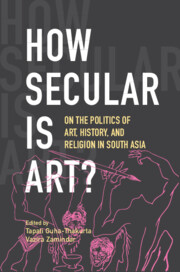7 - Making Place for People?: Geeta Kapur, Secular Nationalism, and ‘Indian’ Art
Published online by Cambridge University Press: 21 February 2023
Summary
Categorical Imperatives
Bullet Shot in the Stomach, 2001 (Image 7.1): The diptych depicts two ageing, white-haired men, one pointing a gun at the other. They are locked in mortal combat. Both figures reveal their internal organs: the one on the left displays a red heart; the one on the right exposes crimson intestines. And yet, does the pistol resemble an oversized phallus? Does it denote tough love or violent aversion? As viewers zoom in on the protagonists, we realize: they are both the same person, self-portraits of their maker—Bhupen Khakhar.
Bullet was painted by Khakhar towards the end of his life, as he battled with cancer (to which he finally succumbed in 2003). Its playful poignance, mingling homoeroticism with anguish, is typical of the dying Khakhar’s last works, where doppelgangers struggle with their conflicted corporeality. Significantly, it was included in Geeta Kapur’s Subject of Death exhibition, one of five group shows she curated as part of Aesthetic Bind (2013) at Bombay’s Chemould—the first Indian gallery to champion the art of the new nation, and the one which played the largest role in Khakhar’s career. Kapur’s attention-grabbing pairing of Khakhar’s demise with the fiftieth anniversary of Chemould’s birth was a deliberate provocation; a demand for the Indian art world to take stock of itself.
Today it seems vital to take up the gauntlet. Such an investigation could not be more urgent: the nation—as much as its art—is in dire need of soul-searching. The country has witnessed the steady rise of the Hindu Right, which achieved political success with the election of its front-man Narendra Modi as prime minister in 2014 and, again, in 2019. Since his second election, Modi has cracked down on India-controlled Kashmir, initiated a series of anti-Muslim citizenship laws (in the form of 2019’s Citizenship Amendment Act), and stirred up border disputes with Pakistan and Bangladesh. If the borderlands face a crisis of identity, the ‘idea of India’ itself is under re-vision, thanks to the governing party’s strategic re-writing of history in which the Mughals are reconfigured as Islamic ‘invaders’. As an ideology, Hindutva instigates sectarian strife; as a political entity it has sparked off Hindu–Muslim rioting in Bombay (1992–1993), Gujarat (2002), and Delhi (2020).
- Type
- Chapter
- Information
- How Secular Is Art?On the Politics of Art, History and Religion in South Asia, pp. 189 - 224Publisher: Cambridge University PressPrint publication year: 2024



